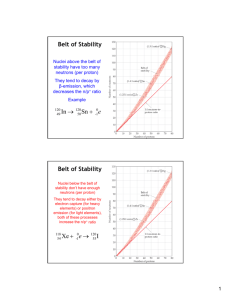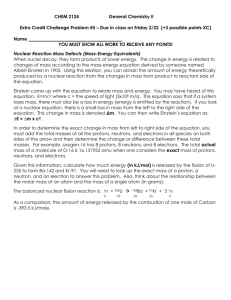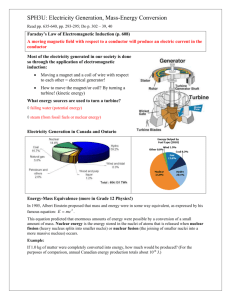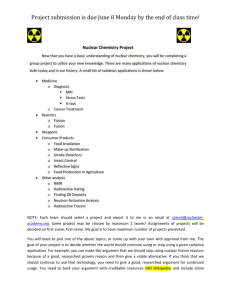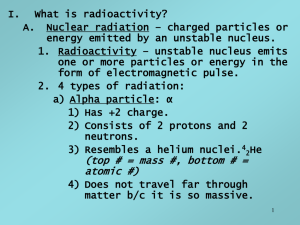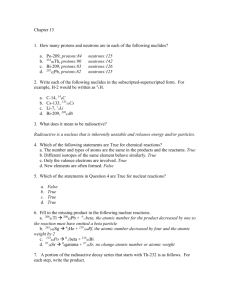lecture slides of chap23
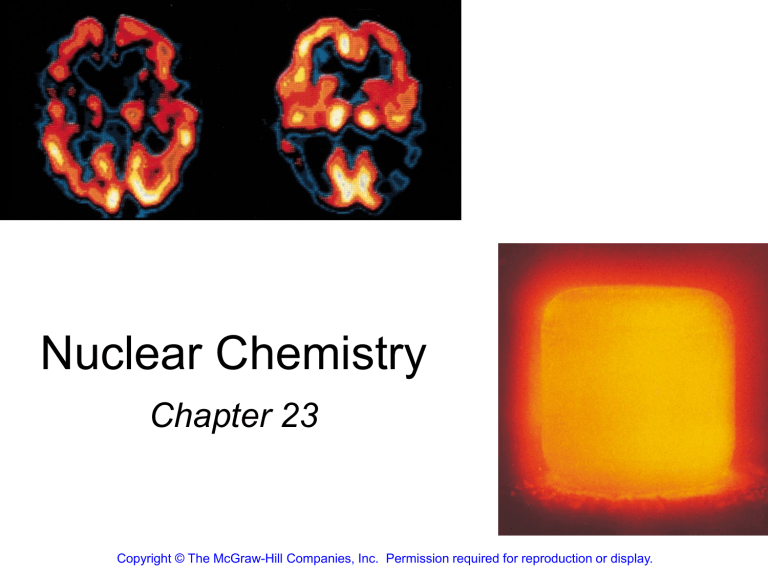
Nuclear Chemistry
Chapter 23
Copyright
© The McGraw-Hill Companies, Inc. Permission required for reproduction or display.
Some nuclei are unstable; they emit particles and/or electromagnetic radiation spontaneously. This phenomenon is radioactivity. All isotopes of the elements with atomic numbers higher than 83 are radioactive.
Mass Number
Atomic Number
A
Z
X
Element Symbol
A
Z
1
1 proton p or
1
1 H
1 neutron
1
0 n
1
1 0
0
-1 electron e or
-1
0 b
0
-1
0
+1 positron e or
+1
0 b
0
+1
4
2 a particle
He or
4
2 a
4
2
23.1
Balancing Nuclear Equations
1. Conserve mass number (A).
The sum of protons plus neutrons in the products must equal the sum of protons plus neutrons in the reactants.
235
92
U + 1
0 n 138
55
Cs +
96
37
Rb
235 + 1 = 138 + 96 + 2x1
+ 2 1
0 n
2. Conserve atomic number (Z) or nuclear charge.
The sum of nuclear charges in the products must equal the sum of nuclear charges in the reactants.
235
92
U + 1
0 n 138
55
Cs + 96
37
Rb
92 + 0 = 55 + 37 + 2x0
+ 2 1
0 n
23.1
212 Po decays by alpha emission. Write the balanced nuclear equation for the decay of 212 Po.
alpha particle -
4
2
He or
4
2 a
212
84
Po 4
2
He + A
Z
X
212 = 4 + A
84 = 2 + Z
A = 208
Z = 82
212
84
Po 4
2
He + 208
82
Pb
23.1
Nuclear Stability
• Certain numbers of neutrons and protons are extra stable
• n or p = 2, 8, 20, 50, 82 and 126
• Like extra stable numbers of electrons in noble gases
(e = 2, 10, 18, 36, 54 and 86)
• Nuclei with even numbers of both protons and neutrons are more stable than those with odd numbers of neutron and protons
• All isotopes of the elements with atomic numbers higher than 83 are radioactive (nuclei are unstable and dissipate excess energy by spontaneously emitting radiation in the form of alpha, beta, and gamma rays)
• All isotopes of Tc (technetium, Z=43) and Pm
(promethium, Z=61) are radioactive
23.2
The principle factor that determines whether a nucleus is stable is the neutron-to-proton ratio (n/P) n/p too large beta decay
X
Y n/p too small positron decay or
Electron capture
23.2
Nuclear Stability and Radioactive Decay
Beta decay (n/P too large; above the belt of stability)
14
6
C 14 N + 0 b
+ n
7 -1
40
19
K 40 Ca + 0 b
+ n
20 -1
Decrease # of neutrons by 1
Increase # of protons by 1
1
0 n 1 p + 0 b
+ n
1 -1
Positron decay (n/P too small)
11
6
C 11 B + 0 b
+ n
5 +1
38
19
K 38 Ar + 0 b
+ n
18 +1
Increase # of neutrons by 1
Decrease # of protons by 1
1
1 p 1 n + 0 b
+ n
0 +1
23.2
Nuclear Stability and Radioactive Decay
Electron capture decay(same effect of positron decay)
37
18
Ar + 0 e 37 Cl + n
-1 17
55
26
Fe + 0 e 55 Mn + n
-1 25
Increase # of neutrons by 1
Decrease # of protons by 1
1
1 p + 0 e 1 n + n
-1 0
Alpha decay
212
84
Po 4
2
He + 208
82
Pb
Decrease # of neutrons by 2
Decrease # of protons by 2
23.2
Nuclear binding energy (BE) is the energy required to break up a nucleus into its component protons and neutrons--a quantitative measure of nuclear stability.
Masses of nuclei are always less than the sum of the masses of
Nucleons --a general term for the protons and neutrons in a nucleus.
Nuclear binding energy (BE) is the energy required to break up a nucleus into its component protons and neutrons--a quantitative measure of nuclear stability.
E = mc 2
BE + 19
9
F 9 1
1 p + 10 1
0 n
ΔE = (Δm)c 2
Δm = 9 x (p mass) + 10 x (n mass) – 19 F mass
Δm(amu) = 9 x 1.007825 + 10 x 1.008665
– 18.9984=0.1587amu
ΔE = (Δm)c 2
Mass defect
= 0.1587amu x(3.00x10
8 m/s) 2 =1.43 x 10 16 amu m 2 /s 2
1 amu = 1.66 x 10 -27 kg 1J= 1kg m 2 /s 2
BE = ΔE =2.37 x 10 -11 J binding energy per nucleon = binding energy number of nucleons
=
2.37 x 10 -11 J
19 nucleons
= 1.25 x 10 -12 J
23.2
Natural radioactivity
Nuclei outside the belt stability, as well as nuclei with more than
83 protons, tend to have spontaneous emission, called radioactivity.
The main types of radiation:
α particles
β particles
Ɣ rays
Electron capture
Positron decay
Kinetics of Radioactive Decay rate = -
-
D
N
D t
D
N
D t rate = l
N
= l
N
N = N
0 exp( l t ) lnN = lnN
0
l t
N = the number of atoms at time t
N
0
= the number of atoms at time t = 0 l is the decay constant l
= ln2 t
½ t
½ half-life
23.3
The half lives have been used as “atomic clocks” to determine the ages of certain objects.
Radiocarbon Dating
14
7
N + 1
0 n 14
6
C + 1
1
H
14
6
C 14
7
N + 0
-1 b
+ n
Uranium-238 Dating t
½
238
92
U 206
82
Pb + 8 4
2 a
+ 6 0
-1 b
= 5730 years t
½
= 4.51 x 10 9 years
It is possible to estimate the ages of the rocks from the mass ratio between
Nuclear Transmutation
14
7
N + 4 a
2
17 O + 1 p
8 1
Transmutation is brought about by the collision of two particles.
14 N( a, p) 7 O
7
8
27
13
Al + 4 a
2
30 P + 1 n
15 0
14
7
N + 1 p 11 C + 4 a
1 6 2
23.4
Worked Example 23.3
Nuclear Transmutation
23.4
Nuclear Fission is the process in which a heavy nucleus
(mass number >200) divides to form smaller nuclei of intermediate mass and one or more neutrons.
Nuclear Fusion is the combining of small nuclei into large ones
Nuclear Fission
235
92
U + 1
0 n 90
38
Sr + 143
54
Xe + 3 1
0 n + Energy
Energy = [(mass 90 Sr + mass 143 Xe + 3 x mass n )-( mass 235 U + mass n )] x c 2
Energy = 3.3 x 10 -11 J per 235 U
= 2.0 x 10 13 J per mole 235 U
23.5
Nuclear Fission
Nuclear chain reaction is a self-sustaining sequence of nuclear fission reactions . The neutron generated in the initial stage of fission can induce fission in other uranium-235 nuclei, which in turn produce more neutrons.
The minimum mass of fissionable material required to generate a self-sustaining nuclear chain reaction is the critical mass .
Non-critical
Critical
23.5
Atomic bomb
The TNT was set off first. The explosion forces the section of fissionable material together to form an amount considerably larger than the critical mass.
Nuclear Fusion
Combining of small nuclei into large ones
2
1
Fusion Reaction
H + 2 H 3 H + 1 H
1 1 1
2
1
H + 3
1
H 4
2
He + 1
0 n
6
3
Li + 2 H 2 4 He
1 2
Energy Released
6.3 x 10 -13 J
2.8 x 10 -12 J
3.6 x 10 -12 J
